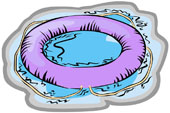Underwater Exploration
BRUCE BECKER'S RESEARCH at Washington State University may be the first of its kind to focus on how warm water affects
the autonomic nervous system. But several other projects are seeking to help facility operators and users better
understand water's healing power.
Among the most significant development is a new aquatic rehabilitation component of the U.S. Army's Wounded Warriors
program. Mary Wykle, a Northern Virginia Community College professor who believes soldiers and athletes have similar
rehab needs, is coordinating the program at Wounded Warrior Transition Units, which provide critical support to wounded
soldiers and their families. Currently piloted at Fort Lewis, Washington, and Virginia-based Fort Eustis and Fort Belvoir,
the aquatic element is expected to eventually involve as many as 10,000 soldiers and will include two phases. One will
prepare the wounded for recovery from injuries, and the other will help them return to active duty or civilian life.
Projected results include pain reduction, enhanced fitness, and improved range of motion, balance, and core and extremity
strength.
While the program isn't formally a research project, data will be gathered on participants' progress by location, gender,
age rank and injury, and then compared to that of soldiers in traditional rehabilitation programs.
"It'll be interesting to see, as the results of that program begin to come in, whether or not there is an enhanced
level of potential funding," says Becker, a physician and WSU research professor who helped design the
aquatics component for the Wounded Warriors program. "Obviously, the thing that we've found with warm-water
immersion may be profoundly helpful in post-traumatic stress disorder."
In other research, Utah State University professor Dennis Dolny is studying how immersion and aquatic exercise can help
arthritis sufferers. The results, gleaned from a one-week exercise program of walking on land versus walking on a water
treadmill, suggest that individuals with arthritis are able to exercise in water with significantly less pain and energy
expenditure. Further studies will determine whether these findings are repeated over the course of eight-, 12- and 16-week
training programs.
And ongoing research by Guy Hornsby Jr., a professor at West Virginia University, focuses on patients with type-2 diabetes
mellitus (T2DM). In a current study, 20 sedentary adult men and women with T2DM have been randomly assigned to either
land-based or aquatic activity for one hour, three times a week for 52 weeks. Most previous studies of diabetics have
remained grounded in land-based exercise, but because many diabetic patients are obese, water exercise is ideal for reducing
stress on joints. With an estimated 21 million North Americans suffering from diabetes and another 41 million thought to
have pre-diabetic symptoms, the results of Hornsby's work could have a significant impact on treatment of the disease.
"Pools, spas and aquatic activity should play a more important role in society," says Thomas Lachocki, chief Executive
Officer of the National Swimming Pool Foundation, which helps fund aquatic research. "The good news is that we have what
society needs." -M.P.
Ongoing Resesarch is at last lending support to the Long-held notion that warm-water immersion does a body good...
from the "Calming Influence" article by Micheal Popke
Choosing the wrong pool construction turns into a real-world
blunder when standard pool construction is used rather than
energy-saving insulated pool wall systems:
In an article from the
Sacramento Bee’s,
February 29, 2008 newspaper,
Deb Kollars writes,
After Big Splash, Folsom Pool Shuts
The big new pool at Vista del Lago, Folsom’s newest high
school, should be filled with shouts and splashes from P.E.
classes and athletes on the swim team.
Instead, the $3 million pool sits unused in silent testimony
to the budget crisis unfolding at schools across the state.
“It’s a shame,” said Joel Garceau, Vista del Lago’s swim
coach. “It’s a fantastic pool. It could be the crown jewel
of the school.”
The Folsom Cordova Unified School District built the pool as
a much-anticipated amenity at Vista del Lago, a striking
campus built on a hill east of Folsom with a view of Folsom
Lake.
The $100 million school, which features contemporary
architecture and ceiling mounted LCD projectors in every
classroom, opened last fall. The 14-lane pool was completed
in early February, Principal John Dixon said.
Shortly afterward, the district determined it could not
afford to heat or operate the pool. The 23 members of the
school’s swimming and diving team ride a bus to practice at
a city pool several miles away.
Debbie Bettencourt, deputy superintendent, said the pool’s
opening came amid a “spending chill” in the district. Like
school systems across the state, Folsom is bracing for
possible budget reductions next year because of the state’s
fiscal crisis. The district is studying how to reduce
spending by $9 million if cuts materialize. “We are looking
at every single expenditure,” she said. “Every dollar we
save this year will help us next year.”
Operating the pool, she said, would take $150,000 a year.
Heating it for two months would cost $25,000. The
district and the city of Folsom had planned to share the
costs and use of the pool, but a joint operating agreement
has not yet been written. Even if the city paid half,
Bettencourt said, she is not sure the district could cover
the rest.
The Vista del Lago swim team got a taste of the new pool
when swim season opened earlier this month. The pool heated,
and in a joyful scene on Feb. 13, Garceau lined his swimmers
along the edge and gave the countdown for their inaugural
leap into the water.
A week later, the heat went off and the team started
commuting to the city pool.
|

 Thinking
Green Thinking
Green
There are several other green
building pool technologies that can be utilized to build an
energy efficient pool, such as:
- pool covers
- running pumps and filters in
off-peak hours
- changing chlorinating
systems to automatic salt-water chlorinators
- installing proper sized
plumbing lines and filters to reduce hydraulic head
pressures
- reducing water turnover
rates
- changing & resetting the
pool clock to run for a much shorter time in the winter
months
- switching to two-speed or
variable-speed electric pumps*
* California’s Pacific Gas &
Electric Company devotes six power plants for the power needs
of the estimated 1.5 million private pools. The report that
by homeowners switching to a new dual or variable speed pump,
the state could omit 2 entire electric generation facilities
while the power customer would see an up to $700 a year cost
reduction. |
return to top
|
Safety First
 |
|
From a safety point of view, omit pool drains completely,
if possible. If not possible with your installation,
install a minimum of two main drains, four feet apart and
make them inlets. On older pool installations, there are
inexpensive vacuum-release systems that can be retrofitted
or convert the drain to an inlet at the equipment pad in such a
way that it can never operate as a main drain again. This will
facilitate in reducing energy-cost to you or your customer.
Suction outlet covers on main drains should be checked often
to prevent entrapment. All should comply with the
Virginia Graeme Baker (VGB) Pool and Spa Safety Act.
(see
PSN article for VGB Requirements for Residential Pools)
Fences
A child’s safety is foremost. When it comes to fencing, ANSI-8
gives specific language and instruction, without exception, pools
must have a barrier, this is not an option. Under the new federal
law, the Virginia Graeme Baker (VGB) Pool and Safety Act, implemented
December 19, 2008, states all pools must be enclosed with a 4' fence,
outward opening, self-latching gate in accordance with ANSI-8.
The Act further states that the house can be considered as one of the
four sides of the fencing barrier as long as any doors opening to the
pool area are equipped with specified devices in place such as pool
guard door alarms. In addition, any above ground pool that is less
than 4 ft. high must also be enclosed with a similar fence. Any access
to the 4' pool also needs to be childproofed. |
Diving Boards
Another point of view spreading is omitting diving
boards; some insurance companies are already denying
insuring homes having diving boards installed on
residential pools and in some cases require removal on
old installations before insuring.
Slides
Slides can be as dangerous as
diving boards, and not so much the slide, but the ladder
and deck below the slide. I’ve known kids who’ve fooled
around trying get to the top first and then fall landing
on the deck below sustaining injuries.
Children should always be
attended by adults anyway when around pools, no matter
how well anyone thinks they can swim.
Safety Covers
We believe that all swimming
pools should have a permanent safety cover installed to
prevent accidental drowning and we recommend that a safety
pool cover be added to the pool as a final and ultimate barrier
so no child or pet can enter the pool when it is closed.
We offer two types of safety covers: an
automatic safety pool
cover or a manually-installed pool cover. Ask us for a quote
on either type of safety cover. |
Providing Energy Efficient solutions
With the cost of energy rising, people are starting
to look for more energy efficient products. Customers are
complaining about cold pools and/or high heating costs. If
you are a homeowner, we are here to help you during the
construction phase of your project. We offer a fresh and
energy-efficient product with our insulated pool wall building
system. It's a unique, innovative and exclusive product. If you
are a pool builder, it's easy to add the "Insulated Pool" to
your current product line as another choice for your customers.
Technology waits for no pool builder.
CEO's Corner
One of my favorite sayings is:
Our company puts the Serve back in "Service"
I like to think that all pool builders are interested in the end
product. I know we are, but first we think about the
consumer and the environment. I want people to
know that when they purchase one of our pool kits, they are
purchasing our expertise as well. Some people may want to
tackle their own projects, others may want help. We make
ourselves available to all pool builders and customers who
purchase our product. That's how we can help you with
quality control on your project, assisting you during the
building process so that you can build it exactly the way it was
meant to be built by the engineering and specifications
About the CEO
Some of My Other InterestsI always treat
people the way I want to be treated and do it with a
smile in my
voice.
Smiling is important because it keeps you healthy and it
can be contagious.
Voice is important because it's our way of communication
whether it's speech or song or even the written word.
I am constantly working on my website to improve it and make it
easier for the consumer, but sometimes I like to go to fun
sites. One of those sites that I thought I could combine
with work was MySpace. Besides thinking it would be a good
way to show off my product, it has been a good way to keep in
touch with friends and family....and most recently....and here's
the fun part....I've found they have Karaoke. So at the
encouragement of my husband, I put a few songs on MySpace.
He thinks I should try out next year for AGT....I don't know if
I'll have the nerve, but it was fun singing because it makes me
smile.
http://kSolo.MySpace.com/167656412 Another
thing I like to do is send cards to family and friends by
SnailMail, but when I don't have time for that I send them
e-cards. I've found a wonderful site that I like because
not only do they have great e-cards (FREE), care2 makes a
difference. They offer causes and news, healthy and green
living tips. One of my favorites is their "a
click a day" motto to help gather donations for worthy causes
such as: global warming, rainforest, oceans, children, pets,
mammals, primates, stopping violence and breast cancer.
For every click, you generate a donation from their sponsors.
It doesn't take too long, so next time you go online to check your
e-mail or whatever...take a moment to check out this great site:
http://www.care2.com/click2donate/ Well,
this is starting to sound like a blog so I guess that's all for
now.
Come back soon, I'm sure I'll have found more to say or
added a new article I've just read from either Aqua or Pool &
Spa News.
return to top

Other Hot Topics
Which Pool Pump Is Better?
New legislation in California, Title 20, states that beginning in January, 2008,
you’ll no longer be able to buy a 1 HP or greater single-speed pump for a new pool
or to replace a failed filter pump. The law will only allow two-speed pumps or
variable-speed pumps. This may leave a mistaken impression that both types
of pumps are equally efficient. They’re not, and a number of utilities, including
Pacific Gas and Electric, have conducted testing that highlights the superior energy
efficiency of variable-speed pumps.
Most would agree that a variable-speed pump is the superior choice and the most
efficient way to go for the energy-conscious pool owner. Two speed or variable-speed
pumps saves two-thirds energy usage over a single-speed pump.
Why Do Pools Have Tile?
The simple reason: reduced maintenance. This little known fact concerning the maintenance role
of tile can be cause for some confusion, even within the swimming pool industry. I'm sure
your wondering how tile can reduce maintenance. On a concrete pool, the tile is used to
create a water line surface that is both nonporous and easy to clean. Body oils and lotions
collect at the water's surface and are responsible for the "scum line." When that scum line
falls onto a porous surface, like plaster, it can be difficult or impossible to clean. For that
reason the tile is used to protect the pool surface from an undesirable stain and allows the
surface to be cleaned easily.
Did You Know?
Canadians are getting a lucky break; in Canada's 2009 federal
budget, they have included a temporary Home Renovation Tax
Credit (HRTC) to help the industry by encouraging homeowners to
make a pool purchase this year. The tax credit is designed
to provide $3 billion to encourage homeowners to invest in
upgrading and renovating their home and backyard.
The HRTC applies to home renovation expenditures made between
January 27, 2009 and February 1, 2010. According to the
newspaper, La Presse, items such as residential swimming pools
are eligible under the tax credit, including in-ground and
permanently installed above-ground pools.
Why didn't we think of that? Better yet, why don't we
suggest it now!
|
Innovative Green Technology
In-ground Insulated Water Structures
I’ve got 40 years experience as a
commercial/residential general contractor and subcontractor from
California through the mid-West. I’ve been directly involved in
all types of building projects, from shopping centers, schools,
apartment projects, power plants as well as building high rise
buildings. I am retired now and know what
I know, know what I think I know and don’t know what I don’t
know.
I built my first pool in Oklahoma
in 1972. Since then, I’ve been involved in every type of pool
construction from block wall pools to metal and acrylic walls
with liners to Gunite, plastered pools. Before I retired due to
health reasons, I was introduced and involved in the engineering
and testing of pools built utilizing this structurally insulated
pool wall panel system.
I've written this because I’m frustrated as a
result of posts I’ve read on various websites. It seems to me,
that some people have failed to recognize that one definition of
a structurally insulated panel building system includes a
structurally-plastered foam panel (SIPS) building system. I feel
that the definition of SIPS has a much broader meaning and use.
This article isn't to promote a company, it's to promote
innovative "green building" technology utilized to build
in-ground insulated water structures.
People tend to approach technology the same way, either in front of them
or behind them, but now they can literally utilize it by swimming in it.
Insulated Pool Wall Systems
The ICC-ES accredited testing
laboratory that tested this engineered-building system in
California was also one of the accredited labs on the West Coast
that tested the reinforced EPS Styrofoam panels with plywood or
OSB panels concurrently, which are presently being utilized in
residential construction. As I have always been interested in
using new construction methods and techniques, which are cost
efficient to the contractor as well as the owner and benefit the
environment, I knew there had to be a better way to build
in-ground water structures.
I implemented this technology into
my construction company in the building of hundreds of pools all
over Northern California from the Sacramento Valley to the High
Sierra. Incidentally, California has the toughest pool
engineering requirements in the nation. There can be as many as
five inspections while a pool is under construction by the
various building departments.
return to top

Speaking From Personal Pool Experience
During that time, I owned a
conventionally built, Gunite-plastered pool at my own residence
(this was my fourth personal pool). I could easily compare
heating costs and usability in relationship to my own pool to
the pools that had built utilizing the structurally insulated
panel system. What most people do not realize is that it’s not
necessarily the ambient air temperature that is the biggest
contributor to the heat loss of the water (this can be
controlled by various types of pool covers), but is the ground
surrounding the pool structure. This is the biggest factor to
the pool water being cold. The average ground temperature in the
summer across the United States will vary from 45 to 58 degrees,
thus any structure in the ground that holds water will tend to
keep the water cold.
 Certainly
in very hot and sunny weather, the pool water will warm up, but
will usually cool down substantially at night. Temperature drops
of 15-20 degrees over night are not uncommon. Even with solar
heat during the summer, the warmest a pool may ever get was 84
degrees, dropping down to the low 70's overnight. Certainly
in very hot and sunny weather, the pool water will warm up, but
will usually cool down substantially at night. Temperature drops
of 15-20 degrees over night are not uncommon. Even with solar
heat during the summer, the warmest a pool may ever get was 84
degrees, dropping down to the low 70's overnight.
Energy Savings

By comparison, insulated pool
owners continually reported their pool temperatures to be 80
degrees in March, unheated, and only loosing 5 to 7 degrees
overnight. They reported having savings of up to 75% compared to
what the costs of heating any other type of pool structure built
with different construction methods.
I've also been told by a number of
customers across the nation (where heating their pools is the
norm because of their climate) that they estimate that their
savings in heating costs would actually pay for the cost of the
installation of the pool in approximately 7 years (based on
usage). One customer in the High Sierras who had built his own
home using the OSB structurally insulated panel system was
specifically looking for a way to insulate his pool because he
realized he could not only incorporate the technology in his
home, but also in his pool. Hundreds of these structures have
been built across the United States and thousands have been
built around the world.
Not too many luxury items will pay for themselves over time, yet
increase the value of one's property. However, it was reported a
few years ago by a Pool and Spa News national study, that
the average pool installation will increase one's property value
from 8 to 12%.
 Building
Green Building
Green To borrow from
the basics of Green Building; "A green building, also known as a
sustainable building or products, is a structure that is
designed, built, renovated, operated, or reused in an ecological
and resource-efficient manner. Green buildings or products are
designed to meet certain objectives such as protecting occupant
health; improving employee productivity; using energy, water,
and other resources more efficiently; and reducing the overall
impact to the environment."
Being a "green technology" company is not just hip or trendy, or
even self-promoting (which some respondents seem to think), and
it is certainly not a fad or a catch-phrase. Dealing with
climate change is a priority for each and every household; every
person and even every business needs to join in this effort.
Whether you’re in the "green technology" business or not,
everyone needs to be informed of the various ways they can be a
part of the worldwide ecological endeavor to reduce energy use
and carbon emissions; utilize and promote green building
programs, to promote sustainable private development in all uses
of energy. This is a proven, economical SIPS technology building
system that works and is just one of the ways to make use of
this in building homes, other building structures and building
insulated in-ground water structures. Any
knowledgeable pool builder or people who are in construction and
are familiar with pool construction can utilize this new
Insulating Therma-Foam System to build thermally-insulated
in-ground concrete pools that are competitively priced to other
pool building systems.
Gunite, metal and acrylic pool walls are not insulated and do
not have any insulating qualities to speak of and in most cases
many of these wall systems are more expensive to purchase, ship
and install than our insulated pool wall building system. We are
the only pool manufacturer in the United States supplying a
patented therma-foam pool wall system to build an
energy-efficient, thermally insulated in-ground concrete pool
and spa, specifically designed to be used with interior finishes
such as composite fiberglass, epoxy or EVM coatings, or
pre-fabricated vinyl liners.
Our insulated pool wall panel system can be
constructed by a two-man crew. The Package Pool Kit is for the
pool builder or virtually anyone with some construction
knowledge or experience. It’s an instance of quality and
function meeting convenience. Costs are rising every where
-- compare our prices -- you may find them less than what you
are currently using.
return to top
More from the CEO's Corner
 |
Old Pools, New Pools,
Green Pools
Pool Greenovations |
I recently read an article in Aqua Magazine, which
talks about energy saving eco-friendly products now becoming
trendier, enticing customers to save a buck....not to mention
the benefits to the earth. A lot of older pools are in
need of upgrading or revamping. Instead of repairing old
equipment, companies are now offering economical and
energy-efficient pumps. This is a good place to start when
you're on a budget. Old pumps consume more energy and with
the new products now available, energy consumption savings can
be anywhere between 30 and 90 percent offering the customers a
$324 to $1,356 savings in yearly utility costs. If
you're looking to save the most in costs, variable speed
programmable pumps are the way to go even though they may
cost a little more. We've always recommended running pool
equipment in off-peak hours as well. The end investment is
well worth it in the energy cost savings to you and the
environment.
Automation of your pool equipment is another way to turn your
pool into a more manageable product. Homeowners are not
pool technicians and an automated pool makes life simpler
optimizing the control of your pump, filter and other items such
as waterfalls, etc. Several manufacturers offer automatic
controllers with salt chlorinator generators, which is a step
forward, not just for power management, but also for chemical
management. These types of system eliminate the use or
reduce the amount of chlorine needed in the pool and the risk of
personal contact with chlorine, a hazardous chemical.
They say LED lighting consumes less power, lasts longer and
saves around 79 percent in energy use.
Heat pumps are now being suggested over gas heaters with
potential cost savings of up to 80 percent. The only
downside is that heat pumps won't operate below 42°, so if you
want to heat your pool during the colder months a gas heater
would work better for on-demand usage. Another alternative
is a heat exchange system that draws heat collected by the
concrete deck.
Another area of renovation and concern is the pool's interior
finish. We recommend the EVM Coating as the interior finish.

More Hot Topics
Pool Drain Covers Need to Be Replaced?
The Virginia Graeme Baker Pool and Spa Safety Act was enacted by Congress
and signed by President Bush on December 19, 2008. Designed to prevent the
tragic and hidden hazard of drain entrapments and eviscerations in pools and spas,
the law became effective on December 19, 2008. Under the law, all public pools
and spas must have ASME/ANSI A112.19.8-2007 compliant drain covers installed and
a second anti-entrapment system installed, when there is only a single main drain.
The law not only applies to commercial swimming pools. Homeowners with private
pools need to make the modifications as well.
One style of the new cover that is being used is raised to prevent bodily entrapment.
It also prevents hair entanglement. This comes in two parts. The inter frame--which you
would put in the existing drain of the pool or spa-- then the new cover goes on top of that,"
Graham said.
Pools with a single drain system need a second level of protection, such as the Safety Vacuum
Release System. The system shuts off the pump if it senses anyone is entrapped.
Are Pool Drains Necessary?
Since 2000 Insulated Pool Kits have been built without pool drains, water is
circulated through strategically positioned inlets and skimmers, eliminating
any dangers of suction entrapments associated with pool main drains. In Florida,
Maria Slaby of Mermaid Pools worked hard to change their laws to build pools
without main drains, which is the only way to build with 100% entrapment protection
--drain free.
In another online article found on
fluent.com and
swimming.about.com, I found it very
interesting that a rocket scientist (Ray Cronise, turned professional pool builder)
had come to the same conclusion that pool drains were not necessary. He ran tests
to simulate the flow of water through computer models of swimming pools with and
without pool drains. The simulation involved placing contaminants in various areas
of the pools and tracking the amount of time needed to remove them using the pool's
circulation system both with and without drains. His conclusions were that inlets and
skimmers alone were sufficient to clear contamination and that main drains not only
were not necessary, but they did not improve the circulation in the pool or enable its
ability to clear contamination.
Common practice in the past with the installation of main drains was for the purpose
of cleaning the bottom of the pool by having the homeowner sweep all pool debris to
the main drain to be flushed through the filter system. This way of cleaning a swimming
pool is antiquated and is no longer practical or safe. All pools need some kind of
automatic pool cleaner whether it is a low voltage robotic cleaner or a suction-side cleaner
operated through the skimmer. These pool cleaning devices move water from all areas of
the pool, will clean all surfaces of the pool, are economical and safe.
return to top
|





